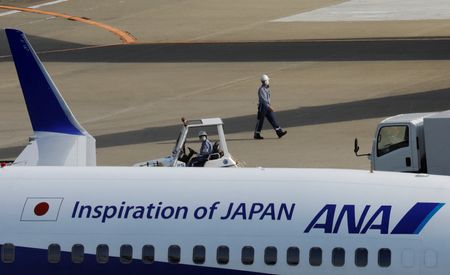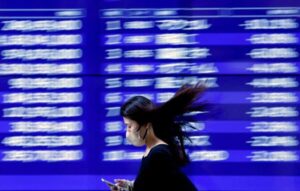TOKYO (Reuters) -ANA Holdings and Japan Airline (JAL) maintained their positive earnings outlooks for the year on Monday as airlines see a strong recovery in demand while grappling with the challenges of COVID-19 and high fuel prices.
A resurgence of the virus in Japan has slowed reservations for domestic flights, but factors including robust demand for international flights continue to support the positive outlook, ANA and JAL executives said.
Both airlines kept their outlook for the current year to March 31, 2023.
“Domestic passenger traffic is expected to be slightly lower than the full-year forecast for the second quarter,” ANA Group CFO Kimihiro Nakahori said. “But international passengers are coming in above full-year earnings expectations” and there is strong performance in cargo, he added.
Domestic flight demand is at risk of weakening as COVID-19 cases surge due to the BA.5 variant, which pushed nationwide cases to a record high 233,094 last week.
For July and August, ANA Holdings’ subsidiaries All Nippon Airways and low-cost carrier Peach Aviation estimated their number of domestic flight passengers would be about 80% pre-pandemic levels.
ANA expects its number of international flight passengers to be over 30% of pre-pandemic levels.
The rise of COVID cases, the Ukraine crisis and rising fuel prices all risk factors which JAL needs to pay attention to, said Hideki Kikuyama, senior managing executive officer.
Both airlines reported narrower operating losses for first quarter.
ANA Holdings posted a 1.3 billion yen ($9.8 million) operating loss for the first quarter versus a loss of 64.6 billion a year earlier.
JAL reported an operating loss of 30.2 billion yen for the April-June quarter versus a loss of 76.8 billion a year earlier.
Both carriers credited strong demand for transit passengers, with JAL reporting that the number of passengers using their flights for transit purposes accounted for 33% of all international flight passengers in the April-June quarter, more than quadrupled from the same period before the pandemic.
“It’s important to cater to that kind of demand,” Kikuyama said.
Japan in June began a gradual reopening to tourists after essentially being shut to non-residents for more than two years as part of pandemic-related measures.
Still, the government is limiting the number of entries to 20,000 people per day including returning residents – a fraction of pre-pandemic levels – and tourists can only visit on guided package tours.
Both ANA’s Nakahori and JAL’s Kikuyama called for the government to further relax entry restrictions and allow individual tourists to be admitted to the country.
($1 = 132.5700 yen)
(Reporting by Satoshi Sugiyama; editing by Tom Hogue and Jason Neely)





